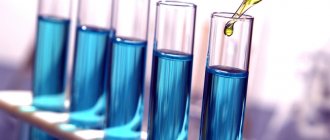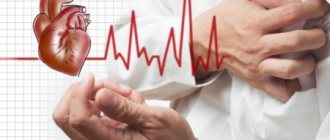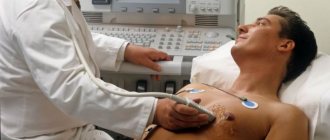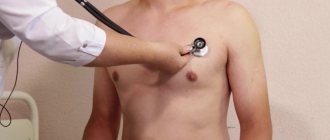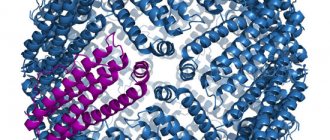A gastroenterologist treats diseases of the pancreas in Nizhny Novgorod.
The pancreas plays a huge role in the human body.
The pancreas is responsible for metabolic and digestive processes in the body.
The pancreas is the most important secretory organ of the human body.
Today, the most popular diseases of the pancreas are treated in Nizhny Novgorod - pancreatitis, pancreatic necrosis, cancer, cysts and diabetes.
Inflammation of the pancreas
Pancreatitis is inflammation of the pancreas and can be acute or chronic. Causes – poor diet, stones in the bile ducts, poisoning, smoking, chronic alcoholism, disruption of the gastrointestinal tract (stomach, duodenum), viral diseases, infections, etc. Symptoms of acute pancreatitis – nausea, vomiting, heartburn, aching, monotonous pain in abdomen, in the left hypochondrium, persisting for several days. As well as spasmodic pain in the lower abdomen, flatulence, abnormal bowel movements (diarrhea or constipation), chills or excessive sweating, an unpleasant taste in the mouth, and changes in skin color.
Reasons for the development of pancreatitis
The disease develops due to damage to pancreatic tissue. This happens for the following reasons:
- alcohol and tobacco abuse
- abdominal trauma, surgery
- uncontrolled and long-term use of medications: antibiotics, hormonal drugs, corticosteroids, some diuretics
- intoxication with food products, chemicals
- genetic predisposition
- improper diet with a predominance of spicy and fatty foods and long breaks between meals
Treatment of pancreatic inflammation
Treatment of acute pancreatitis should take place in a hospital.
First aid - you need to apply an ice bag to the left hypochondrium, avoid eating any food. Drug treatment includes taking antispasmodics, painkillers (opioid analgesics), and antiemetics. In the acute phase, infusion drugs are administered intravenously. For complications, antibiotics may be prescribed. Fasting is observed for three to five days or parenteral nutrition is used.
Therapy for the chronic form of the disease is based on quitting smoking, drinking alcohol, diet therapy with a small amount of fat in the diet, using painkillers, taking enzyme preparations; antidepressants (pregabalin, gabapentin) can be prescribed to relieve pain, as well as treatment of complications.
If there are stones in the gland ducts, then it is rational to perform lithotripsy and endoscopic therapy.
Surgical treatment is performed when drug therapy is impossible or the body is tolerant to their action.
The duration of treatment depends on the form and complications of the disease, and on the body’s susceptibility to therapy.
Pancreatic tumors
A pancreatic tumor can be of two types – cancer and a hormonally active tumor.
Men are more often affected; the average age is 55 years. Most often the tumor is localized in the head of the gland. Factors that provoke the development of pancreatic cancer include smoking, chronic pancreatitis, high body mass index, and male gender.
Symptoms of cancer depend on the part of the gland that is affected. If the head of the gland is affected, jaundice may develop, because compression of the bile duct occurs. Skin itching appears. When the body and tail are affected, diabetes mellitus, varicose veins of the esophagus and stomach, and the risk of bleeding develop.
Treatment is surgical or chemotherapy.
University
Diseases of the gastrointestinal tract are not so terrible compared to those that the whole world fears (such as cancer and AIDS), and yet.
What is pancreatitis?
Gennady Kondratenko, Head of the 1st Department of Surgical Diseases of the Belarusian State Medical University, Doctor of Medical Sciences, Professor: The pancreas, in general, meets two tasks in the body, the most important, fundamentally very important tasks. This is the first thing - it is involved in the digestive conveyor, and the second thing is that it regulates blood sugar. Inflammation of the pancreas in acute or chronic form is called pancreatitis. It should be noted right away that the incidence of acute pancreatitis has a worldwide upward trend. The attention of the surgical community around the world, including our Belarusian surgical community, is focused on this disease. We see an increase in Belarus, including severe forms of pancreatitis, and we are concerned about this.
Gennady Kondratenko: “The incidence of acute pancreatitis has a worldwide upward trend. We see an increase in Belarus, including severe forms of pancreatitis, and we are concerned about this.”
Interesting fact. We are afraid of heart attack, stroke, cancer - the main leaders in mortality in the world. And we completely forget, or rather, we know little about such an insidious disease as pancreatitis.
Alexey Protasevich, Associate Professor of the 1st Department of Surgical Diseases of the Belarusian State Medical University, Candidate of Medical Sciences: We can say that this is even a fatal disease. Particularly acute pancreatitis is a potentially fatal disease.
Alexey Protasevich: “We can say that this is even a fatal disease. Especially acute pancreatitis is a potentially fatal disease.”
Due to its unpredictability and transience.
Alexey Protasevich: Dies somewhere in the range of 20-30% of cases.
So what is this monster that can take a person's life in the blink of an eye?
Alexey Protasevich: This is the death of pancreatic tissue.
It would seem that this is a very small organ - no more than 50 g of weight, and its disease can lead to the malfunction of other vital organs.
Alexey Protasevich: In the beginning, to improper functioning of the heart, lungs, liver, kidneys, and sometimes the brain. If detoxification is not done, your patient may die from heart failure.
Fortunately, this organ has one advantage. Let's face it: somewhat reassuring.
Alexey Protasevich: The pancreas is created with a large margin of safety. You can be missing 90% of your pancreas and not have diabetes or enzyme deficiency. Therefore, in principle, God created the pancreas seriously.
And to damage it, you have to try really hard.
Causes of the disease
Alexey Protasevich: For men, in the overwhelming majority of cases, the reason is drinking alcohol.
And in any form and in any quantity.
Alexey Protasevich: If a person drinks alcohol regularly and a lot, he will 100% develop cirrhosis of the liver.
And for the development of pancreatitis, a single dose is enough.
Alexey Protasevich: The so-called alcoholic excess can lead to the development of severe acute pancreatitis.
Alexey Protasevich: “The so-called alcoholic excess can lead to the development of severe acute pancreatitis.”
For women, the main cause of pancreatitis can be disease of the gallbladder and bile ducts. What is the connection, you ask? Yes, the most direct one.
Alexey Protasevich: Bile enters the duodenum through a duct that passes in the head of the pancreas. Just before entering the duodenum, the pancreatic duct merges with the bile duct.
Such anatomical proximity leads to the fact that the ill-fated pebbles also injure the pancreas, thereby causing pancreatitis in women. The insidiousness of the disease also lies in the fact that in some cases the cause of its occurrence cannot be established.
Alexey Protasevich: This is the so-called idiopathic pancreatitis. A number of reasons remain closed, since there is a connection with genes, with the patient’s congenital predisposition to developing this particular disease.
Alexey Protasevich: “A number of reasons remain closed, since there is a connection with genes, with the patient’s congenital predisposition to developing this particular disease.”
Fortunately, there are few such cases - about 10% of the total number of cases. So judge for yourself that in the overwhelming majority of cases the cause of the development of such an unpredictable disease is our very predictable actions. And that's a fact.
Chronic pancreatitis
Gennady Kondratenko: This is observed when small, long-term, repeated inflammations of the pancreatic tissue lead to degeneration of this tissue and the replacement of this functional tissue with connective scar tissue. Thus, the digestive function of the pancreas becomes weaker, digestive problems arise in these patients, moderate constant or periodic pain occurs in the upper abdomen, stool becomes upset, and diarrhea occurs. Such patients also need to be treated with replacement therapy, and they must always follow a diet. The reason for its development is the same: excessive consumption of alcohol, let’s say, and food, especially fatty and spicy food, well, and also carrying stones for a long time, cholelithiasis, which is not operated on in a timely manner. Then, when a person already has a chronic form of pancreatitis, does not pay attention to it, leads an unhealthy lifestyle, a picture develops that is almost completely identical to acute pancreatitis.
Gennady Kondratenko: “Then, when a person already has a chronic form of pancreatitis, does not pay attention to it, leads an unhealthy lifestyle, a picture develops that is almost completely identical to acute pancreatitis.”
Treatment
Gennady Kondratenko: I would like to note that this acute onset requires immediate delivery to the emergency rooms of those hospitals where there are surgical departments. Why a surgical hospital? Because after all, this is a surgical disease. In some cases, surgical intervention for this disease will be indicated. There are very severe forms of pancreatitis that can be treated in intensive care. The only wish, of course, is that they don’t go to the clinic, perhaps, because delays in providing assistance play a significant role in the further course of pancreatitis.
Patients with acute pancreatitis are most often admitted to the hospital in severe form for one simple reason - late presentation.
Anastasia Khatkovskaya, anesthesiologist-resuscitator: A day, two, some stay at home for a week, at best, they self-medicate, at worst, they do nothing. Many people abuse alcohol the day before and often don’t even remember the onset of symptoms.
Anastasia Khatkovskaya: “They stay at home for a day, two days, some for a week, at best they self-medicate, at worst they do nothing. “Many people abuse alcohol the day before and often don’t even remember the onset of symptoms.”
Perhaps these are the most common mistakes made by patients.
Yan Kernozhitsky, surgeon of the 1st emergency surgical department of the 10th City Clinical Hospital of Minka: We are used to doing everything “at random”. What if it goes away? You hear all this from probably 100% of those who arrived on the second or third day.
For many, this “maybe” costs their life.
Jan Kernozhitsky: We are losing time to start massive infusion therapy.
Therefore, once again about the symptoms.
Symptoms
Alexey Protasevich: The main clinical manifestation of acute pancreatitis is epigastric pain.
Or, as ordinary people say, “in the pit of the stomach.” The pain may radiate to the right or left hypochondrium. And, as a rule, it is encircling in nature.
Alexey Protasevich: “The main clinical manifestation of acute pancreatitis is epigastric pain.”
Alexey Protasevich: Further down the list there is nausea, vomiting, usually uncontrollable, then bloating, then general symptoms of intoxication in the form of tachycardia, shortness of breath, general weakness.
Unfortunately, acute pancreatitis can masquerade as other diseases.
Alexey Protasevich: Most often confused with gastritis and peptic ulcers.
Hence the late seeking of medical help and, as a consequence. decreased effectiveness of therapy.
Alexey Protasevich: “Most often confused with gastritis and peptic ulcers.”
Anastasia Khatkovskaya: A person comes in in a dehydrated state, because a very large loss of fluid occurs due to the inflammatory process that occurs in the abdomen, and blood thickening occurs. Therefore, the first aid that we provide as anesthesiologists and resuscitators consists of massive infusion therapy.
Often the infusion reaches 6-8 liters of fluid per day.
Anastasia Khatkovskaya: Without this, a person, in principle, within a day or two can go into intoxication shock and die.
Diagnostics
Here, in the intensive care unit, the simplest, but proven over the years, diagnostic method is performed - ultrasound.
Alexey Protasevich: If we are talking about severe cases, if we need to know all the information about the condition of the pancreas, this is, of course, computed tomography. Now there are works on magnetic resonance imaging. It appears to provide virtually the same amount of information as a CT scan.
If the patient’s body does not respond adequately to therapy from the first days of treatment or surgical intervention is planned, doctors use another diagnostic method.
Alexey Protasevich: So-called endosonoscopy. This is an endoscopy, but when a small ultrasound sensor is attached to the endoscope sensor. And we actually put the sensor through the duodenum onto the pancreas, and therefore we get very detailed information. a very reliable image of the condition of the pancreas.
Finally, a classic blood test.
Alexey Protasevich: For the purpose of increasing pancreatic enzymes in it. That is, these are the three signs of acute pancreatitis - the presence of pain, increased enzymes and ultrasound signs of inflammation of the pancreas.
Alexey Protasevich: “Three signs of acute pancreatitis are the presence of pain, elevated enzymes and ultrasound signs of inflammation of the pancreas.”
Anastasia Khatkovskaya: If the patient was admitted two days, three days after the onset of the disease, of course, it is no longer possible to interrupt the process. The process has been started, a cascade of pathological mechanisms has been launched.
Pancreatic stones
Pancreolithiasis is the formation of stones in the pancreatic ducts.
Often stones form if there is a cyst or tumor; this is one of the complications of chronic pancreatitis. Stagnant processes occur in the organ, the secretion of the pancreas thickens, and the protein precipitates. The ducts dilate, the pressure in them increases, and symptoms of pancreatitis appear. Symptoms of pancreolithiasis:
- burning pain in the abdomen radiating to the back and shoulder blade;
- nausea, vomiting with bile;
- steatorrhea – “fatty” stool;
- diabetes;
- increased salivation;
- obstructive jaundice.
Tachycardia with pancreatitis
The pancreas and the heartbeat are closely related structures, since with the development of acute pancreatic inflammation in the cavity of the parenchymal gland, the level of heartbeat begins to increase, exceeding the limits of 100 beats per minute. An increase in the rhythm of the heartbeat may affect the patient’s general well-being, or it may go unnoticed. In such situations, tachycardia is determined only by listening to the pulse and heartbeat.
The main reason for the development of tachycardia in pancreatic disease may be either an increase in temperature and the development of intoxication processes extending beyond the abdominal cavity, or a peculiar reaction of the body to developing pancreatic pain and disturbed psycho-emotional balance in the patient.
It is also worth noting that the development of tachycardia can occur with low blood pressure, which is a characteristic symptom in the acute form of pancreatic pathology, accompanied by the formation of painful shock.
Symptomatic signs of tachycardia appear:
- high heart rate;
- the appearance of a feeling of weakness throughout the body;
- lack of air;
- attacks of dizziness;
- sensations of possible loss of consciousness.
Treatment of tachycardia is based on eliminating the underlying disease in an adult and relieving pain.
Diagnosis of pancreatic diseases
To diagnose diseases of the pancreas, the doctor examines and palpates the abdomen and prescribes laboratory and instrumental methods.
A biochemical blood test examines the level of pancreatic enzymes (amylase, lipase), blood glucose, and liver function tests.
A stool analysis is carried out to assess the deficiency of enzyme production, the presence of undigested food, fat, and certain enzymes (pancreatic elastase) is examined.
Visual instrumental examinations are carried out using transabdominal ultrasound (ultrasound of the abdominal cavity), CT, radiography, magnetic resonance cholangiopancreatography.
First aid and treatment for heart pain
In all pathological conditions, it is necessary, first of all, to relieve pain with the help of antispasmodic intramuscular drugs, such as Papaverine or Platiphylline. Then, after the diagnosis is established, medications are prescribed to treat the pancreas. The most important condition for inflammation of the pancreas is to temporarily provide a state of rest for this organ using enzyme replacement therapy. For patients with pancreatitis, it is important to follow a strict diet that excludes fried foods and high-fat foods.
Diet for diseases of the pancreas
The diet should include soft, well-chopped food.
Steam, bake, boil, stew foods. Include puree soups and cream soup in your diet. Bread can be consumed dried, yesterday's bread made from first and second grade flour. Meat - chicken, turkey, lean parts of beef, low-fat fish is allowed. Eggs should be in the form of omelettes, steamed in the oven. You can eat non-acidic types of fruits, baked fruits. You can drink rosehip decoction, sugar-free compote, herbal teas, water. Of the fats in the diet, butter with 82.5% fat content and sunflower oil should be present, but limited. Food should be taken warm. It is necessary to exclude sausages, smoked meats, fatty, fried, canned and pickled foods.
Forbidden:
- alcohol;
- spicy food;
- coffee;
- energy, carbonated sweet drinks;
- chocolate;
- ice cream;
- duck, goose meat, pork, lard, bacon;
- legume products;
- garlic, cabbage;
- grapes, bananas.
The severity of the diet depends on the disease of the pancreas. In the acute period, fasting is prescribed for three to five days; in case of exhaustion, parenteral and special enteral nutrition is used.
How to distinguish angina from pancreatitis
In fact, the clinical manifestations of angina and an attack of pancreatitis are very similar. But there are still differences.
An attack of pain syndrome with pancreatic damage to the pancreas begins to develop after consuming foods prohibited for pancreatitis with a high percentage of pungency or fat content, as well as after drinking alcohol. But the pain of angina pectoris begins to appear after excessive physical exertion on the body.
It is also worth noting that with angina pectoris, a one-time feeling of nausea may occur with further discharge of vomit, and with pancreatic disease, vomiting and nausea are constant symptomatic signs with repeated manifestations.
